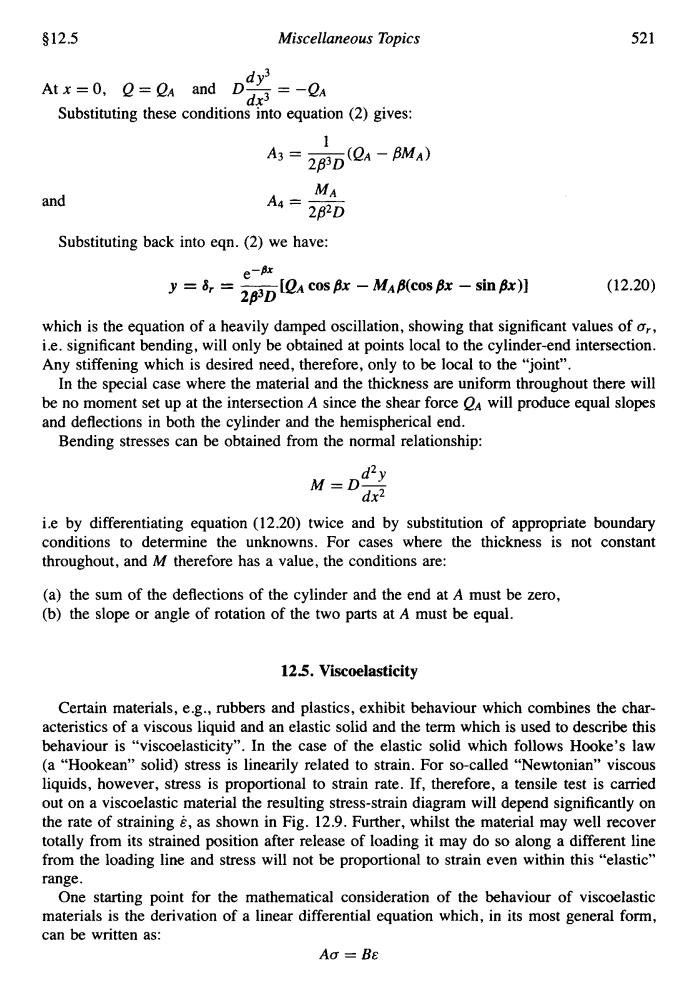正在加载图片...

§12.5 Miscellaneous Topics 521 At x=0.2=e and Ddy dx3=-0 Substituting these conditions into equation(2)gives: 1 A3 =28D(QA BMA) MA and A4= 282D Substituting back into eqn.(2)we have: e-fr y=8r= D[c0sBx-M(cos B-sin Bx)] (12.20) which is the equation of a heavily damped oscillation,showing that significant values of or, i.e.significant bending,will only be obtained at points local to the cylinder-end intersection. Any stiffening which is desired need,therefore,only to be local to the "joint". In the special case where the material and the thickness are uniform throughout there will be no moment set up at the intersection A since the shear force O4 will produce equal slopes and deflections in both the cylinder and the hemispherical end. Bending stresses can be obtained from the normal relationship: y M=D dx2 i.e by differentiating equation(12.20)twice and by substitution of appropriate boundary conditions to determine the unknowns.For cases where the thickness is not constant throughout,and M therefore has a value,the conditions are: (a)the sum of the deflections of the cylinder and the end at A must be zero, (b)the slope or angle of rotation of the two parts at A must be equal. 12.5.Viscoelasticity Certain materials,e.g.,rubbers and plastics,exhibit behaviour which combines the char- acteristics of a viscous liquid and an elastic solid and the term which is used to describe this behaviour is "viscoelasticity".In the case of the elastic solid which follows Hooke's law (a "Hookean"solid)stress is linearily related to strain.For so-called "Newtonian"viscous liquids,however,stress is proportional to strain rate.If,therefore,a tensile test is carried out on a viscoelastic material the resulting stress-strain diagram will depend significantly on the rate of straining e,as shown in Fig.12.9.Further,whilst the material may well recover totally from its strained position after release of loading it may do so along a different line from the loading line and stress will not be proportional to strain even within this "elastic" range. One starting point for the mathematical consideration of the behaviour of viscoelastic materials is the derivation of a linear differential equation which,in its most general form, can be written as: Ao=BE912.5 Miscellaneous Topics 521 dY3 Atx=O, Q=QA and D- =-QA dx3 Substituting these conditions into equation (2) gives: 1 A3 = -(QA - BMA) 283 D and MA 2B2D A4 = - Substituting back into eqn. (2) we have: e-BX y = 6, = - [QA cos ,9x - MA COS ,9x - sin px)] (12.20) which is the equation of a heavily damped oscillation, showing that significant values of a,., i.e. significant bending, will only be obtained at points local to the cylinder-end intersection. Any stiffening which is desired need, therefore, only to be local to the “joint”. In the special case where the material and the thickness are uniform throughout there will be no moment set up at the intersection A since the shear force QA will produce equal slopes and deflections in both the cylinder and the hemispherical end. 2,933~ Bending stresses can be obtained from the normal relationship: d2Y M=Ddx2 i.e by differentiating equation (12.20) twice and by substitution of appropriate boundary conditions to determine the unknowns. For cases where the thickness is not constant throughout, and M therefore has a value, the conditions are: (a) the sum of the deflections of the cylinder and the end at A must be zero, (b) the slope or angle of rotation of the two parts at A must be equal. 125. Viscoelasticity Certain materials, e.g., rubbers and plastics, exhibit behaviour which combines the characteristics of a viscous liquid and an elastic solid and the term which is used to describe this behaviour is “viscoelasticity”. In the case of the elastic solid which follows Hooke’s law (a “Hookean” solid) stress is linearily related to strain. For so-called “Newtonian” viscous liquids, however, stress is proportional to strain rate. If, therefore, a tensile test is carried out on a viscoelastic material the resulting stress-strain diagram will depend significantly on the rate of straining E, as shown in Fig. 12.9. Further, whilst the material may well recover totally from its strained position after release of loading it may do so along a different line from the loading line and stress will not be proportional to strain even within this “elastic” range. One starting point for the mathematical consideration of the behaviour of viscoelastic materials is the derivation of a linear differential equation which, in its most general form, can be written as: Aa = BE